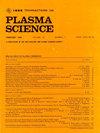Numerical Investigation of Runaway Electrons During the Breakdown of Homogeneous Electric Field Air Gaps Under Nanosecond Pulse Voltage
IF 1.3
4区 物理与天体物理
Q3 PHYSICS, FLUIDS & PLASMAS
引用次数: 0
Abstract
The development of discharge that starts near the cathode in a homogeneous electric field air gap under nanosecond pulse voltage is studied using a 2.5-D particle-in-cell/Monte Carlo collisional model. The simulation is first performed in the absence of photoionization reactions. It is found that runaway electrons are produced in the head of the streamer when the local electric field strength is sufficiently high. Runaway electrons ionize the area in front of the streamer tip while producing abundant preionization electrons, which significantly accelerate the rate of discharge propagation. Photoelectrons and runaway electrons perform an analogous role in preionizing gas, but the latter is more efficient because of their directionality. A more complete discharge process is simulated in the presence of photoionization reactions. Electrons with relatively high energy appear in the bipolar end of the discharge channel while the discharge continuously progresses toward the anode. During the later moment of discharge, the streamer expands to the anode at an extremely fast velocity as a result of the combined action of photoionization and runaway electrons located at the negative streamer tip. The simulation results reveal the discharge mechanisms of the air gap applied with a homogeneous electric field under a nanosecond voltage pulse and provide a comprehensive understanding of the fast breakdown of air gaps.纳秒脉冲电压下均匀电场气隙击穿过程中失控电子的数值研究
采用2.5维电池内粒子/蒙特卡罗碰撞模型研究了纳秒脉冲电压下均匀电场气隙中阴极附近开始放电的发展过程。模拟首先在没有光电离反应的情况下进行。研究发现,当局部电场强度足够大时,流线头部会产生失控电子。逃逸电子电离了流光尖端前部的区域,同时产生了大量的预电离电子,显著加快了放电的传播速度。光电子和失控电子在预电离气体中起着类似的作用,但后者由于其方向性而更有效。在存在光电离反应的情况下,模拟了一个更完整的放电过程。在放电通道的双极端出现能量较高的电子,放电过程不断向阳极推进。在放电后期,由于光电离和位于负流光尖端的失控电子的共同作用,流光以极快的速度膨胀到阳极。仿真结果揭示了在纳秒电压脉冲作用下均匀电场作用下气隙的放电机理,为气隙的快速击穿提供了全面的认识。
本文章由计算机程序翻译,如有差异,请以英文原文为准。
求助全文
约1分钟内获得全文
求助全文
来源期刊

IEEE Transactions on Plasma Science
物理-物理:流体与等离子体
CiteScore
3.00
自引率
20.00%
发文量
538
审稿时长
3.8 months
期刊介绍:
The scope covers all aspects of the theory and application of plasma science. It includes the following areas: magnetohydrodynamics; thermionics and plasma diodes; basic plasma phenomena; gaseous electronics; microwave/plasma interaction; electron, ion, and plasma sources; space plasmas; intense electron and ion beams; laser-plasma interactions; plasma diagnostics; plasma chemistry and processing; solid-state plasmas; plasma heating; plasma for controlled fusion research; high energy density plasmas; industrial/commercial applications of plasma physics; plasma waves and instabilities; and high power microwave and submillimeter wave generation.
 求助内容:
求助内容: 应助结果提醒方式:
应助结果提醒方式:


